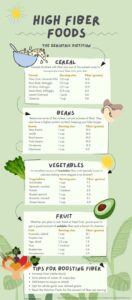Fast Facts on Dietary Fiber and Your Health
Fast Facts on Dietary Fiber and Your Health

Dietary fibers are the non-starch forms of carbohydrate obtained from plants and the human body cannot digest them.
Research has found an adequate intake of dietary fiber helps to reduce the risk of a number of cancers like breast cancer and colorectal cancer.
Dietary fibers are classified as soluble and insoluble but most fiber-rich foods contain both types in varying degrees. The two types function differently in the body.
Image from: https://agamatrix.com/blog/high-fiber-foods-diabetes/
Two Types of Dietary Fiber
Soluble Fiber absorbs water and becomes gel in the intestine. This gel helps to slow digestion and is helps to lower your blood cholesterol. Food sources of Soluble Fiber: oatmeal, barley, nuts, seeds, peas, beans, lentils, carrots, cucumbers, apples, oranges, pears, berries.
Insoluble Fiber adds bulk to stools and helps to promote regular bowels movements. Eating a high fiber diet helps your body to digest foods and eliminate them faster. Food sources of Insoluble Fiber: include whole bran, nuts, whole grain products, corn, carrots, grapes, berries, and apple or pear peels.
Unlike protein, fats and carbohydrates which are the parts of food that your body digests and absorb, dietary fiber passes through your digestive system intact. Dietary fiber is not considered a nutrient since your body doesn’t digest or absorb fiber but is an essential part of a healthy diet.
Health Benefits of Dietary Fiber
- Healthy Weight Loss
- Weight Management
- Lower Diabetes Type 2 Risk
- Lower risk of Heart Disease
- Increased Beneficial Gut Bacteria
- Reduced Risk of Certain Cancers like Colorectal Cancer & Breast Cancer
- Longer Life
- More Regular Bowel Movements
- All-Natural Detox
Daily Dietary Fiber Goals Recommendations
- Eat 3 or more pieces of fruit each day.
- Eat 3 or more ½-cup servings of vegetables each day.
- Eat beans 4 times a week in salad, chili, or side dishes.
Note: Don’t like vegetables much you can create some really great Fruit-Veggie smoothies: fruit, yogurt or milk, with added spinach or kale, chia seeds, flaxseed and ice or use frozen fruits.
How Many Grams of Dietary Fiber do You Need Each Day?
Age Men Women
19-30 34 grams 28 grams
31 – 49 31 grams 25 grams
Over 50 24 grams 22 grams
Dietary Fiber requirements for children and teens:
- Children 1 to 3 years: 19 grams of fiber/day.
- Children 4 to 8 years: 25 grams of fiber/day.
- Boys 9 to 13 years: 31 grams of fiber/day.
- Girls 9 to 13 years: 26 grams of fiber/day.
- Boys 14 to 19 years: 38 grams of fiber/day.
- Girls 14 to 19 years: 26 grams of fiber/day.
If you normally don’t eat much dietary fiber but have decided to increase your daily intake of dietary fiber, start slow. Eating too much fiber to quickly can cause bloating, cramping and gas until your gut get use to more dietary fiber. Drinking more fluids throughout the day will also help dietary fiber pass through the gut more effectively. Use the lists below to determine how much dietary fiber you are eating daily. You can also find the dietary fiber by looking at the Nutrition Facts label.

Printable List of High Fiber Foods (Free download!)
Dietary Fiber: Nutrient-densea Food and Beverage Sources, Amounts of Dietary Fiber and Energy per Standard Portion
FOODbc | STANDARD | CALORIES | FIBER | ||
Grains | |||||
Ready-to-eat cereal, high fiber, unsweetened | 1/2 cup | 62 | 14.0 | ||
Ready-to-eat cereal, whole grain kernels | 1/2 cup | 209 | 7.5 | ||
Ready-to-eat cereal, wheat, shredded | 1 cup | 172 | 6.2 | ||
Popcorn | 3 cups | 169 | 5.8 | ||
Ready-to-eat cereal, bran flakes | 3/4 cup | 98 | 5.5 | ||
Bulgur, cooked | 1/2 cup | 76 | 4.1 | ||
Spelt, cooked | 1/2 cup | 123 | 3.8 | ||
Teff, cooked | 1/2 cup | 128 | 3.6 | ||
Barley, pearled, cooked | 1/2 cup | 97 | 3.0 | ||
Ready-to-eat cereal, toasted oat | 1 cup | 111 | 3.0 | ||
Oat bran | 1/2 cup | 44 | 2.9 | ||
Crackers, whole wheat | 1 ounce | 122 | 2.9 | ||
Chapati or roti, whole wheat | 1 ounce | 85 | 2.8 | ||
Tortillas, whole wheat | 1 ounce | 88 | 2.8 | ||
Vegetables | |||||
Artichoke, cooked | 1 cup | 89 | 9.6 | ||
Navy beans, cooked | 1/2 cup | 128 | 9.6 | ||
Small white beans, cooked | 1/2 cup | 127 | 9.3 | ||
Yellow beans, cooked | 1/2 cup | 128 | 9.2 | ||
Lima beans, cooked | 1 cup | 209 | 9.2 | ||
Green peas, cooked | 1 cup | 134 | 8.8 | ||
Adzuki beans, cooked | 1/2 cup | 147 | 8.4 | ||
French beans, cooked | 1/2 cup | 114 | 8.3 | ||
Split peas, cooked | 1/2 cup | 116 | 8.2 | ||
Breadfruit, cooked | 1 cup | 170 | 8.0 | ||
Lentils, cooked | 1/2 cup | 115 | 7.8 | ||
Lupini beans, cooked | 1/2 cup | 115 | 7.8 | ||
Mung beans, cooked | 1/2 cup | 106 | 7.7 | ||
Black turtle beans, cooked | 1/2 cup | 120 | 7.7 | ||
Pinto beans, cooked | 1/2 cup | 123 | 7.7 | ||
Cranberry (roman) beans, cooked | 1/2 cup | 121 | 7.6 | ||
Black beans, cooked | 1/2 cup | 114 | 7.5 | ||
Fufu, cooked | 1 cup | 398 | 7.4 | ||
Pumpkin, canned | 1 cup | 83 | 7.1 | ||
Taro root (dasheen or yautia), cooked | 1 cup | 187 | 6.7 | ||
Brussels sprouts, cooked | 1 cup | 65 | 6.4 | ||
Chickpeas (garbanzo beans), cooked | 1/2 cup | 135 | 6.3 | ||
Sweet potato, cooked | 1 cup | 190 | 6.3 | ||
Great northern beans, cooked | 1/2 cup | 105 | 6.2 | ||
Parsnips, cooked | 1 cup | 110 | 6.2 | ||
Nettles, cooked | 1 cup | 37 | 6.1 | ||
Jicama, raw | 1 cup | 46 | 5.9 | ||
Winter squash, cooked | 1 cup | 76 | 5.7 | ||
Pigeon peas, cooked | 1/2 cup | 102 | 5.7 | ||
Kidney beans, cooked | 1/2 cup | 113 | 5.7 | ||
White beans, cooked | 1/2 cup | 125 | 5.7 | ||
Black-eyed peas, dried and cooked | 1/2 cup | 99 | 5.6 | ||
Cowpeas, dried and cooked | 1/2 cup | 99 | 5.6 | ||
Yam, cooked | 1 cup | 158 | 5.3 | ||
Broccoli, cooked | 1 cup | 54 | 5.2 | ||
Tree fern, cooked | 1 cup | 56 | 5.2 | ||
Luffa gourd, cooked | 1 cup | 100 | 5.2 | ||
Soybeans, cooked | 1/2 cup | 148 | 5.2 | ||
Turnip greens, cooked | 1 cup | 29 | 5.0 | ||
Drumstick pods (moringa), cooked | 1 cup | 42 | 5.0 | ||
Avocado | 1/2 cup | 120 | 5.0 | ||
Cauliflower, cooked | 1 cup | 34 | 4.9 | ||
Kohlrabi, raw | 1 cup | 36 | 4.9 | ||
Carrots, cooked | 1 cup | 54 | 4.8 | ||
Collard greens, cooked | 1 cup | 63 | 4.8 | ||
Kale, cooked | 1 cup | 43 | 4.7 | ||
Fava beans, cooked | 1/2 cup | 94 | 4.6 | ||
Chayote (mirliton), cooked | 1 cup | 38 | 4.5 | ||
Snow peas, cooked | 1 cup | 67 | 4.5 | ||
Pink beans, cooked | 1/2 cup | 126 | 4.5 | ||
Spinach, cooked | 1 cup | 41 | 4.3 | ||
Escarole, cooked | 1 cup | 22 | 4.2 | ||
Beet greens, cooked | 1 cup | 39 | 4.2 | ||
Salsify, cooked | 1 cup | 92 | 4.2 | ||
Cabbage, savoy, cooked | 1 cup | 35 | 4.1 | ||
Cabbage, red, cooked | 1 cup | 41 | 4.1 | ||
Wax beans, snap, cooked | 1 cup | 44 | 4.1 | ||
Edamame, cooked | 1/2 cup | 94 | 4.1 | ||
Okra, cooked | 1 cup | 36 | 4.0 | ||
Green beans, snap, cooked | 1 cup | 44 | 4.0 | ||
Hominy, canned | 1 cup | 115 | 4.0 | ||
Corn, cooked | 1 cup | 134 | 4.0 | ||
Potato, baked, with skin | 1 medium | 161 | 3.9 | ||
Lambsquarters, cooked | 1 cup | 58 | 3.8 | ||
Lotus root, cooked | 1 cup | 108 | 3.8 | ||
Swiss chard, cooked | 1 cup | 35 | 3.7 | ||
Mustard spinach, cooked | 1 cup | 29 | 3.6 | ||
Carrots, raw | 1 cup | 52 | 3.6 | ||
Hearts of palm, canned | 1 cup | 41 | 3.5 | ||
Mushrooms, cooked | 1 cup | 44 | 3.4 | ||
Bamboo shoots, raw | 1 cup | 41 | 3.3 | ||
Yardlong beans, cooked | 1/2 cup | 101 | 3.3 | ||
Turnip, cooked | 1 cup | 34 | 3.1 | ||
Red bell pepper, raw | 1 cup | 39 | 3.1 | ||
Rutabaga, cooked | 1 cup | 51 | 3.1 | ||
Plantains, cooked | 1 cup | 215 | 3.1 | ||
Nopales, cooked | 1 cup | 22 | 3.0 | ||
Dandelion greens, cooked | 1 cup | 35 | 3.0 | ||
Cassava (yucca), cooked | 1 cup | 267 | 3.0 | ||
Asparagus, cooked | 1 cup | 32 | 2.9 | ||
Taro leaves, cooked | 1 cup | 35 | 2.9 | ||
Onions, cooked | 1 cup | 92 | 2.9 | ||
Cabbage, cooked | 1 cup | 34 | 2.8 | ||
Mustard greens, cooked | 1 cup | 36 | 2.8 | ||
Beets, cooked | 1 cup | 49 | 2.8 | ||
Celeriac, raw | 1 cup | 66 | 2.8 | ||
Fruit | |||||
Sapote or Sapodilla | 1 cup | 217 | 9.5 | ||
Durian | 1 cup | 357 | 9.2 | ||
Guava | 1 cup | 112 | 8.9 | ||
Nance | 1 cup | 82 | 8.4 | ||
Raspberries | 1 cup | 64 | 8.0 | ||
Loganberries | 1 cup | 81 | 7.8 | ||
Blackberries | 1 cup | 62 | 7.6 | ||
Soursop | 1 cup | 148 | 7.4 | ||
Boysenberries | 1 cup | 66 | 7.0 | ||
Gooseberries | 1 cup | 66 | 6.5 | ||
Pear, Asian | 1 medium | 75 | 6.5 | ||
Blueberries, wild | 1 cup | 80 | 6.2 | ||
Passionfruit | 1/4 cup | 57 | 6.1 | ||
Persimmon | 1 fruit | 118 | 6.0 | ||
Pear | 1 medium | 103 | 5.5 | ||
Kiwifruit | 1 cup | 110 | 5.4 | ||
Grapefruit | 1 fruit | 130 | 5.0 | ||
Apple, with skin | 1 medium | 104 | 4.8 | ||
Cherimoya | 1 cup | 120 | 4.8 | ||
Durian | 1/2 cup | 179 | 4.6 | ||
Starfruit | 1 cup | 41 | 3.7 | ||
Orange | 1 medium | 73 | 3.7 | ||
Figs, dried | 1/4 cup | 93 | 3.7 | ||
Blueberries | 1 cup | 84 | 3.6 | ||
Pomegranate seeds | 1/2 cup | 72 | 3.5 | ||
Mandarin orange | 1 cup | 103 | 3.5 | ||
Tangerine (tangelo) | 1 cup | 103 | 3.5 | ||
Pears, dried | 1/4 cup | 118 | 3.4 | ||
Peaches, dried | 1/4 cup | 96 | 3.3 | ||
Banana | 1 medium | 112 | 3.2 | ||
Apricots | 1 cup | 74 | 3.1 | ||
Prunes or dried plum | 1/4 cup | 105 | 3.1 | ||
Strawberries | 1 cup | 49 | 3.0 | ||
Dates | 1/4 cup | 104 | 3.0 | ||
Blueberries, dried | 1/4 cup | 127 | 3.0 | ||
Cherries | 1 cup | 87 | 2.9 | ||
Protein Foods | |||||
Wocas, yellow pond lily seeds | 1 ounce | 102 | 5.4 | ||
Pumpkin seeds, whole | 1 ounce | 126 | 5.2 | ||
Coconut | 1 ounce | 187 | 4.6 | ||
Chia seeds | 1 Tbsp | 58 | 4.1 | ||
Almonds | 1 ounce | 164 | 3.5 | ||
Chestnuts | 1 ounce | 106 | 3.3 | ||
Sunflower seeds | 1 ounce | 165 | 3.1 | ||
Pine nuts | 1 ounce | 178 | 3.0 | ||
Pistachio nuts | 1 ounce | 162 | 2.9 | ||
Flax seeds | 1 Tbsp | 55 | 2.8 | ||
Hazelnuts (filberts) | 1 ounce | 178 | 2.8 | ||
a All foods listed are assumed to be in nutrient-dense forms; lean or low-fat and prepared with minimal added sugars, saturated fat, or sodium.
b Some fortified foods and beverages are included. Other fortified options may exist on the market, but not all fortified foods are nutrient-dense. For example, some foods with added sugars may be fortified and would not be examples in the lists provided here.
c Some foods or beverages are not appropriate for all ages, (e.g., nuts, popcorn), particularly young children for whom some foods could be a choking hazard
d Portions listed are not recommended serving sizes. Two lists—in ‘standard’ and ‘smaller’ portions–are provided for each dietary component. Standard portions provide at least 2.8 g of dietary fiber. Smaller portions are generally one half of a standard portion.
Data Source: U.S. Department of Agriculture, Agricultural Research Service. FoodData Central, 2019. fdc.nal.usda.gov.

By Barbara Day, M.S., R.D. is a registered dietitian with a Master’s Degree in clinical nutrition. She is the Chief Blog Organizer for www.DayByDayLiving.net
Barbara worked as a research nutritionist with the military’s tri-service medical school & working as a performance nutrition consultant to Navy SEALS’ BUD/S Training Program and West Coast active Navy SEAL Teams. Barbara is the former nutrition performance consultant to the University of Louisville Athletic Department. She is the author of Fast Facts on Fast Food For Fast People and High Energy Eating Sports Nutrition Workbook for Active People used by the University of Louisville, University of Tennessee Lady Vols and the Tennessee football program, the LSU basketball program, the Buffalo Bills, the Cleveland Browns and by the United States Navy SEALs.
The former publisher of Kentuckiana HealthFitness Magazine, Kentuckiana Healthy Woman magazine and radio show host of Health News You Can Use, Barbara has over 30 years of experience in promoting healthy lifestyles to consumers. Barbara is a former runner who walks, a spinner, hiker a mother and grandmother to 13 grandchildren.

